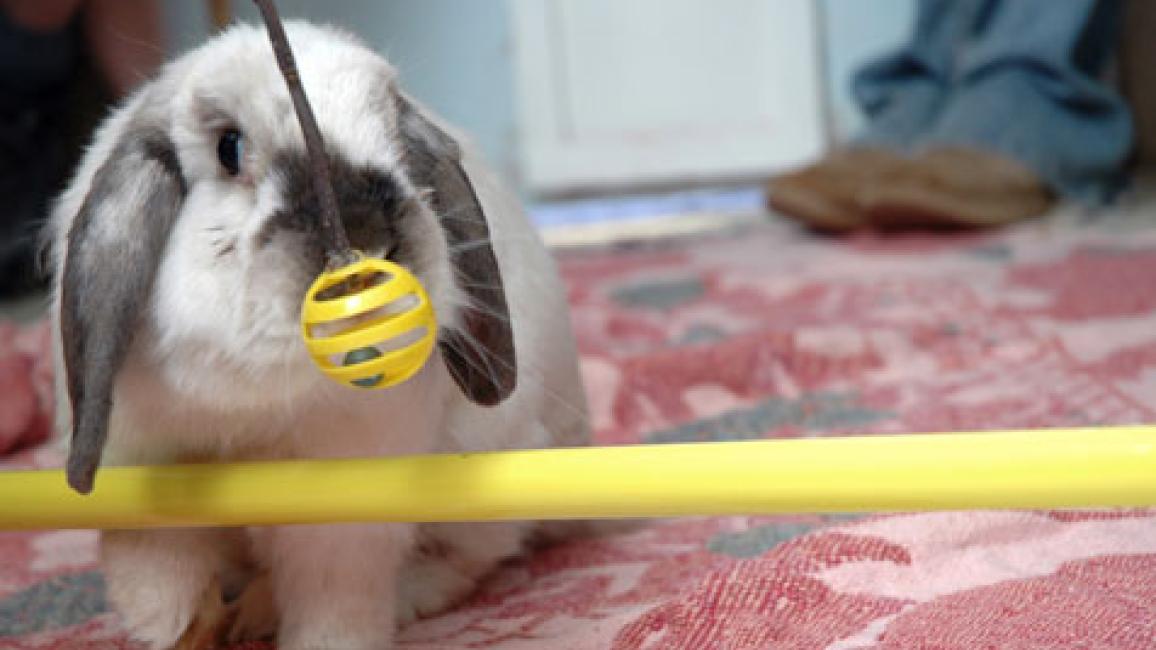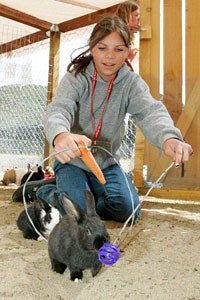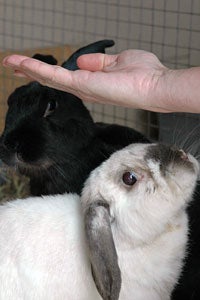Training your rabbit

Most people probably wouldn’t be shocked if, while strolling through a park, they saw a dog sit or roll over on cue. Swap the dog for a rabbit, however, and, more likely than not, at least a few heads would turn. The truth is rabbits can learn to sit, jump hurdles, run obstacles, place a ball through a hoop and more, all on cue. "They are intelligent, curious animals who can be trained to do a variety of tasks," explains Best Friends rabbit manager Debby Widolf.
Teaching a rabbit to use the litter box
One such handy task is learning to use a litter box. The concept of a litter box is actually a natural fit for a rabbit. "In their natural environment, they pick spots to go to the bathroom," explains Debby. Get more information on how to litter box train your rabbit.
Training rabbits vs. training dogs

Clicker training works!
Admittedly, training rabbits is a slightly different deal than training dogs. One of the big differences is that rabbits are prey animals, whereas dogs are predators. With a rabbit, you generally have to spend much more time earning their trust before they are willing to follow suggestions or instructions. In fact, building trust with a rabbit is actually one of the best side effects to doing the training in the first place.
Consider the Reno rabbit rescue several years ago. For those unfamiliar with this rescue, it involved over 1,000 rabbits who’d been living in a single backyard. When Best Friends went in to help, the rabbits were nowhere near ready to interact with people. Some simple clicker training made a huge difference.
"These rabbits were really terrified, and we had to work with them," says Debby. "We had to move them; we had to find homes for them. We needed a method to show them they could trust us, and clicker training worked."
Here’s how they did it. Staff members and volunteers would hold out a target stick, or sometimes they’d use a carrot as the "stick." Whenever the rabbit got close enough to the target stick (overcoming their fear of the person), they would hear a click and receive a small treat or bite of the carrot. If the rabbit came a little closer, they’d get an even bigger treat. With this basic training exercise, the staffers and volunteers were able to gain the trust of the rabbits.
Bunny tricks
Of course, once a pet rabbit is feeling trusting and happy, that’s when the fun can begin if the rabbit has the right personality. Rabbits can learn to stand, sit, lie down, give kisses, run obstacles and plenty more. Since the training is all reward based, the rabbits are always motivated. Just be sure not to overload them with calories along the way.

Rabbits can sit, lie down, and more!
"You don’t want to give them something high in sugar or high in fat as a treat," Debby points out. You can use small bites of tasty greens, tiny pieces of whole grain crackers, food pellets, or if you really want to get them motivated, a few Cheerios in limited amounts can work wonders.
Such training sessions end up being a blast for the rabbits, so long as they decide to participate in the first place. Again, most of this is up to the rabbit. Even when treats are involved, if the rabbit doesn’t enjoy the training, he or she simply won’t bother. On the other hand, if the rabbits like the training (and many do), you can hardly keep them from practicing on their own!
Clicker training for bunnies
Clicker training expert Andrea Bratt Frick, who incidentally taught clicker techniques to Best Friends staff and volunteers during the Reno rescue (and provided additional training for them at the Sanctuary), has several rescue rabbits of her own she can hardly keep away from the training equipment. Check out her video to see these former rescue rabbits in action!
There’s a wealth of information online and in bookstores about clicker training. One website Debby recommends is Clicker Bunny. With a little extra time and effort, you may discover a whole new side to your rabbit you never knew existed!